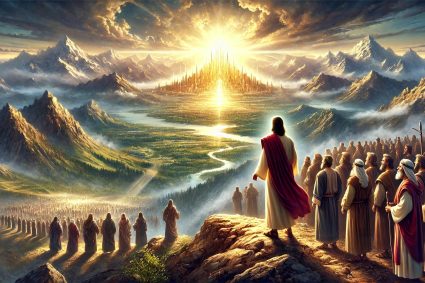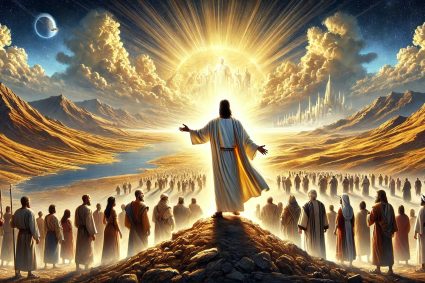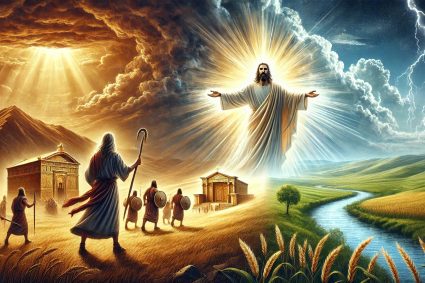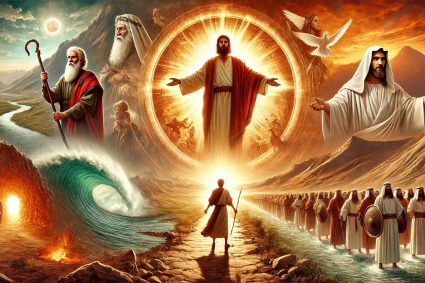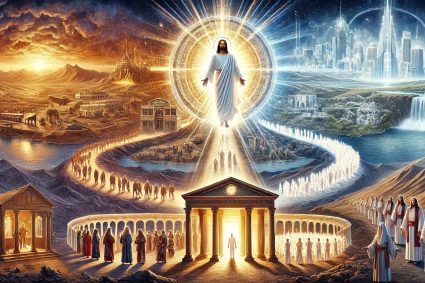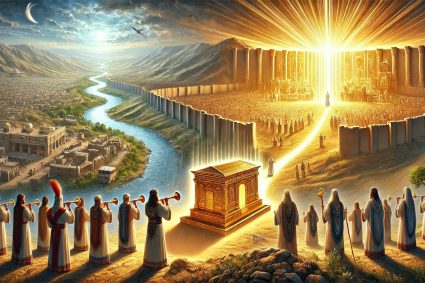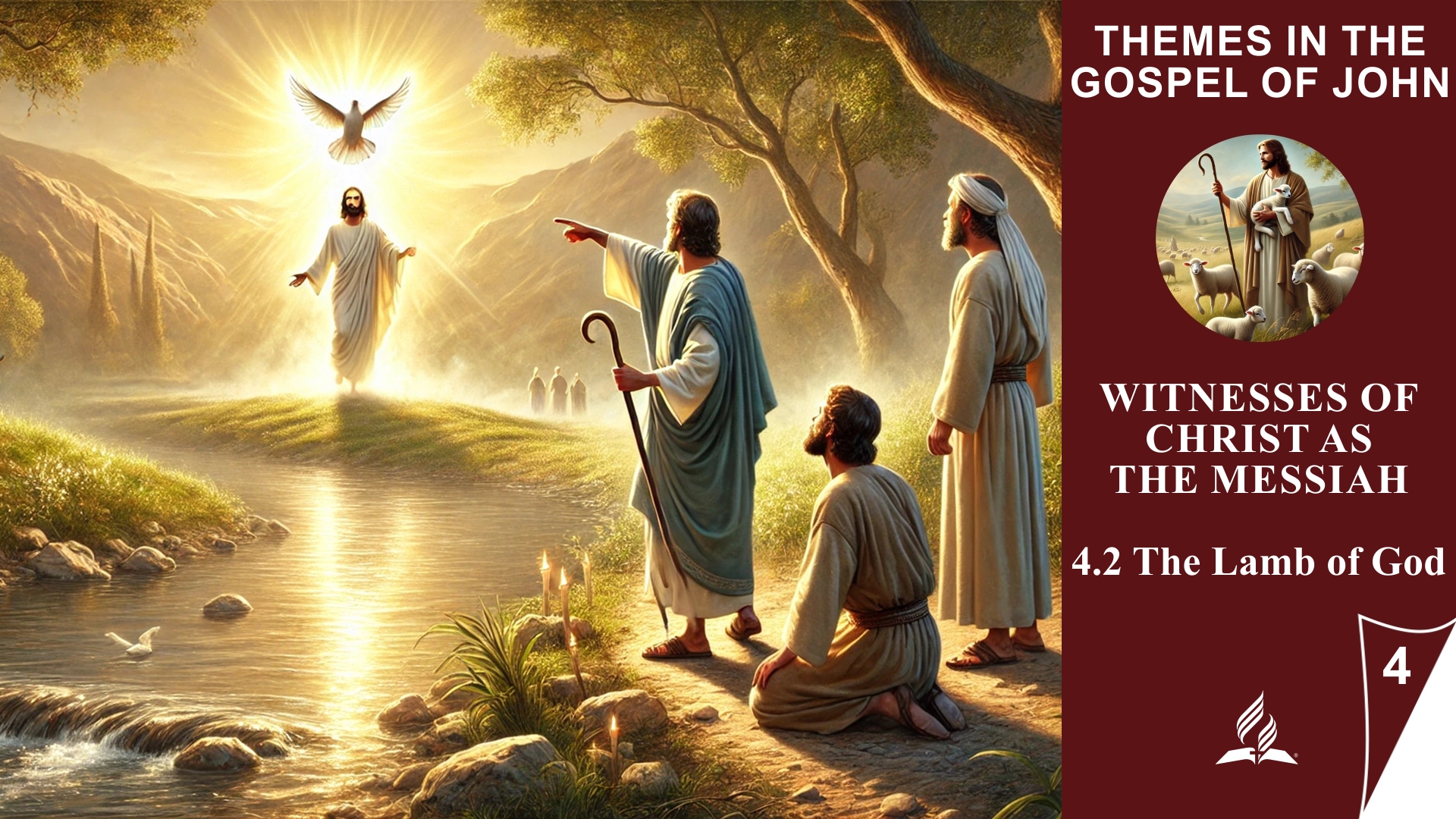


4.2 The Lamb of God
Jesus, the Lamb of God: The Messiah as a Sacrifice for the World
Read John 1:29–37. What announcement does John the Baptist make about Jesus? What image does he use to depict him, and why is this so significant for understanding who Jesus was and what his mission would be?
The image of Jesus as “the Lamb of God” is central to understanding his mission and identity in the Gospel of John. The Hebrew people were seeking a Messiah who would free them from Roman rule. However, John the Baptist introduced a completely new understanding of the Messiah by referring to Jesus as the Lamb of God. This portrayal is deeply symbolic and goes beyond political or military expectations. It presents Jesus as the one who has come to fulfill the Old Testament prophecies about the Redeemer—especially through his sacrifice for the sins of the world.
The Significance of the Lamb of God
In John 1:29–37, John the Baptist refers to Jesus as “the Lamb of God, who takes away the sin of the world.” This image of the lamb alludes to the Old Testament sacrificial system, where lambs were offered as atonement for the sins of the people. Particularly during the Passover, the Passover lamb was slaughtered to remember the liberation of Israel from Egypt and to save the people from the consequences of death. By identifying Jesus as the Lamb of God, John points to Jesus’ role as the ultimate sacrifice that frees humanity not only from temporary difficulties but from the eternal power of sin.
Fulfillment of Old Testament Promises
John the Baptist, through his statement, brings the Old Testament sacrificial system into a new perspective. Jesus is not merely a teacher or prophet but the true sacrificial lamb who fulfills the promises of the Redeemer, which were already hinted at in Genesis 3:15. Isaiah 53:7, the “lamb led to the slaughter,” is perfectly realized in Jesus Christ. John the Baptist indicated Jesus’ impending sacrifice, which would restore the relationship between God and humans.
Significance for the Gospel of John
The Gospel of John aims to expand the understanding of the Messiah. John the Baptist made it clear that Jesus was not an earthly ruler or military liberator but the one who would bring deeper liberation from sin and death through his own life and death. By calling Jesus the Lamb of God, John indicates that Jesus’ true mission was not to establish a political kingdom but to redeem humanity through his sacrifice.
Relevance for Believers Today
The image of the Lamb of God reminds us of the redeeming power of Jesus Christ and the depth of his love, demonstrated through his sacrifice. For believers today, this understanding is significant as it leads us to gratitude for the gift of redemption and highlights the necessity of a renewed relationship with God. Jesus, the Lamb of God, paid the highest price to free us from the power of sin and to make us children of God.
Overall, John the Baptist’s testimony shows that Jesus was not merely a prophet or king but the sacrificial lamb who redeems the world from sin. His ministry and sacrifice fulfilled Old Testament prophecies and transformed humanity’s understanding of who the Messiah is and what he would do.
Read Mark 10:45; Romans 5:6; and 1 Peter 2:24. How do these verses help us understand Jesus’ role as “the Lamb of God”?
The three mentioned verses—Mark 10:45, Romans 5:6, and 1 Peter 2:24—provide deep insights into Jesus’ role as “the Lamb of God” and help us better understand his mission and sacrifice.
Mark 10:45: “For even the Son of Man did not come to be served, but to serve, and to give his life as a ransom for many.”
This verse highlights Jesus’ essential role as servant and sacrifice. Jesus did not come to rule humanity as a powerful sovereign but to sacrifice himself for people. The image of “ransom” shows that Jesus, through his voluntary sacrifice, frees humanity from the bondage of sin. His role as the “Lamb of God” is evident here: he is the sacrifice that brings redemption to all humanity.
Romans 5:6: “You see, at just the right time, when we were still powerless, Christ died for the ungodly.”
In this verse, Paul describes the unconditional love and sacrifice of Jesus. Christ died for us when we were still sinful and unable to save ourselves. This sacrifice is the central role of the “Lamb of God”: Jesus took the punishment we deserved because of our sins. He died in our place to give us life. His death was necessary to bridge the gap between God and fallen humanity.
1 Peter 2:24: “He himself bore our sins in his body on the tree, that we might die to sin and live to righteousness. By his wounds you have been healed.”
This verse directly connects the idea of the “Lamb of God” with Jesus’ atoning sacrifice on the cross. Jesus carried the sins of humanity in his own body and took the punishment upon himself to free us from sin. This concept harks back to the Old Testament image of the sacrificial lamb, which was offered on behalf of the people’s sins. Through his wounds and suffering, we are spiritually healed and made righteous before God.
Connection to the Role of the “Lamb of God”
These three verses collectively illustrate the significance of Jesus’ role as “the Lamb of God”:
-
Sacrifice and Redemption: Jesus willingly sacrifices himself out of love to redeem humanity from sin.
-
Substitution: Like the Old Testament sacrificial lamb, Jesus bears our guilt so that we may be freed from the punishment of sin.
-
Healing and Righteousness: Through his death and wounds, we are spiritually healed, renewed, and led to righteousness.
John the Baptist, although he might not have fully understood the depth of Jesus’ work, recognized that Jesus was the promised Messiah who came to fulfill these prophecies. Jesus as the “Lamb of God” embodies the perfect sacrifice that overcomes the separation between God and humanity and opens the way to a new life in God.
Reflect deeply on this title for Jesus: “the Lamb of God.” What images come to mind, and how does the connection to the Old Testament sacrificial system help you understand the high price of our redemption?
When we reflect deeply on the title “the Lamb of God,” several powerful images emerge, each carrying profound spiritual significance. This title connects Jesus with the Old Testament sacrificial system and helps us see the high price of our redemption in a new light.
Images and Symbols
-
The Passover Lamb: One of the first images that come to mind is the Passover lamb. In the Book of Exodus, the lamb is slaughtered, and its blood is smeared on the doorposts to protect the Israelites from the angel of death (Exodus 12). In Jesus, we see the ultimate Passover lamb whose blood saves us not from physical death but from eternal death. His sacrifice means that we are saved not only from earthly dangers but from the power of sin and death.
-
The Innocent Lamb: A lamb symbolizes innocence and purity. When we consider Jesus as “the Lamb of God,” we think of his perfectly pure nature—he was without sin and utterly innocent. In Jewish tradition, a sacrificial lamb had to be flawless, and Jesus was exactly that: faultless, ready to give himself up for others. This image of purity underscores the contrast between humanity’s sinfulness and Jesus’ holiness.
-
The Sacrificial System: In the Old Testament sacrificial system, lambs were regularly offered as atonement for the people’s sins. However, these sacrifices were only temporary solutions that had to be repeated continually. Jesus, the “Lamb of God,” came to offer a single, ultimate sacrifice. His death on the cross fulfills the role of the perfect sacrifice, completed once and for all (Hebrews 10:10). This image shows the finality and completeness of his sacrifice.
The High Price of Redemption
The connection to the Old Testament sacrificial system allows us to understand the high price of our redemption:
-
A Sacrifice for the Entire World: In the Old Testament system, sacrifices were limited to the people of Israel. But Jesus, as the “Lamb of God,” bears the sins of the entire world. His sacrifice is universal, applicable to all people at all times.
-
Inexhaustible Love: The image of the Lamb of God also leads us to recognize God’s immeasurable love. The Father gave his own Son to die for our sins. Jesus’ sacrifice was not a light or symbolic one—it was real and involved profound suffering. This demonstrates the extremely high price paid for our salvation.
-
Freedom and Grace: Through the Lamb of God’s sacrifice, we are freed from the burden of sin. The price Jesus paid grants us freedom—not only from punishment but also from the power of sin over our lives. His grace allows us to live in a new relationship with God.
Conclusion
The image of Jesus as “the Lamb of God” is deep and meaningful. It reminds us that our redemption came at a high price—the innocent life of Jesus. Through his sacrifice, the Old Testament sacrifices were fulfilled and surpassed. It shows us the depth of God’s love and the completeness of Jesus’ work, which not only frees us from sin but also leads us to new life in Him.
The image of Jesus as “the Lamb of God” holds not only deep theological significance but also a direct connection to our everyday lives and faith. It reminds us of the fundamental sacrifice Jesus made for us and calls us to live in gratitude and devotion. Here are some concrete connections that this image has to our daily life and faith:
-
Gratitude for the Sacrifice When we think of Jesus as “the Lamb of God,” we become aware of the magnitude of the sacrifice he made for us. In our daily lives, we can express this gratitude by living consciously, focusing on God, and appreciating both small and large blessings. It reminds us that our lives are a gift bought with the blood of Jesus.
-
Encouragement to Humility and Devotion Jesus, who was innocent, gave his life as a sacrifice for us. This image challenges us to live with humility and align our own lives with the needs of others. In our faith and daily life, this means not putting ourselves at the center but serving in the footsteps of Jesus and sharing the love he has shown us.
-
Freedom from Sin Jesus’ sacrifice frees us not only from the punishment for sin but also from its power over our lives. In our daily lives, we can continually remind ourselves of this freedom. We are no longer slaves to sin but have the opportunity to walk in a new life through the “Lamb of God.” This freedom allows us to make more conscious decisions and live a life that honors God.
-
A Life of Renewal Through the sacrifice of the “Lamb of God,” we are able to have a renewed relationship with God. This directly affects our daily lives by giving us the opportunity each day to repent, forgive, and walk in a new life. Our faith becomes vibrant as we remember daily that we are spiritually renewed through Jesus.
-
Vigilance and Preparation Just as Jesus was the lamb who takes away the world’s sin, we are called to be vigilant and prepare for his return. Our faith should not only focus on the present but also on God’s promises and the eternal redemption offered through Jesus Christ. This awareness shapes our daily lives as we live in anticipation of Jesus’ return and strive to be ready as his followers.
-
A Model of Service Mark 10:45 shows us that Jesus came to serve and give his life. We should integrate this model into our faith and daily lives by learning to live not just for ourselves but also for others. Serving in the family, workplace, or community means seeing the needs of others and acting with love—just as Jesus was sacrificed as the Lamb for us.
Conclusion
The image of Jesus as “the Lamb of God” holds powerful significance for our faith and daily lives. It calls us to gratitude, humility, freedom from sin, continual renewal, vigilance, and a life of service. These insights help us live in the presence of Jesus’ sacrifice and deepen our relationship with God each day. Just as Jesus gave his life to redeem the world, we are called to live our lives in devotion to him and to our fellow human beings.

Live today in gratitude and humility, mindful of the sacrifice Jesus made as the Lamb of God for us.
Visited 97 times, 1 visit(s) today

